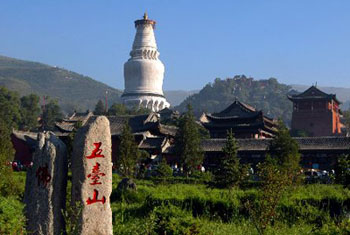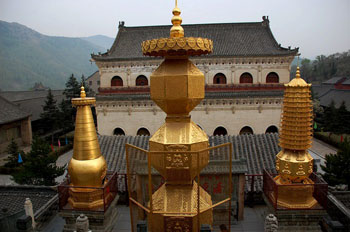search for a Trip
Mount Wutaishan in Shanxi Province
Wutai Mountain has the longest and most prestigious history in the four well-known Buddhist holy lands and the only mountain where both Chinese Buddhism and Tibetan Lamaism are practiced.
For hundreds of years, Wutai Mountain has been China's most sacred Buddhist ground mainly because it was where the highly revered Manjusri, the Bodhisattva of wisdom, once lived and taught Buddhism. As the most trusted aide of Sakyamuni, the founder of Buddhism, he drew emperors from various dynasties here on pilgrimages, adding more significance to the mountain. Wutai Mountain is a famous scenic spot under national protection.
Located in Shanxi Province's Wutai Country, 240 kilometers from the provincial capital of Taiyuan, the mountain is actually a cluster of five terrace-like peaks, hence the name Wutai(Five Terraces). Its cool and pleasant summer climate has also given rise to another name: Qingliang(Cool and Pleasant) Mountain. The mountain has been regarded as an ideal place for escaping summer heat since ancient times.
During the reign of the Emperor Mingdi of the Eastern Han dynasty (25-220), people started to cut into the mountain and build temples there. In later dynasties building and repairing of the temple continued, which resulted in a large complex of ancient structures. In its heyday, the mountain had over 300 temples housing more than 10,000 monks. Today, 47 of these temples are still in good condition. Within their walls is a rich legacy of over 100,000 superb sculptures and paintings, along with a great quantity of Buddhist cultural relics.


Mt. Wutaishan Scenery
The beautiful scenery of Mt. Wutaishan is a masterpiece of exquisite acts of nature, predominantly visible over the five main peaks: Wanghai Peak in the east, Guayue Peak in the west, Jinxiu Peak in the south, Yedou Peak in the north, and the central Cuiyan Peak.
Wanghai Peak (Peak Overlooking the Sea) in the east
1 kilometer (0.6 mile) east of Taihuai Town in Wutai County, there is Wanghai Peak. Visitors standing on the top of the peak, east of Mt. Wutaishan, can appreciate the height of 2,795 meters (9,169.9 feet). It is wonderful to see the sunrise in the morning from this location. Out of a sea of floating clouds and writhing mist, the sun rises with thousands of golden rays. It fills visitors with amazement, as they can believe it is the sun rising above the real sea.
Guayue Peak (Hanging Moon Peak) in the west
Guayue Peak reaches an altitude of 2,773 meters (9,097.8 feet) and is 13 kilometers (8.1 miles) west of Taihuai Town. This peak provides unique imagery in the evening when visitors can see the elegant and serene sight of the graceful but hazy moon hanging above dense pine trees.
Jinxiu Peak (Splendor Peak) in the south
Jinxiu Peak is 2,485 meters high (8,152.9 feet), and 12 kilometers (7.5 miles) south of Taihuai Town. This peak's beauty is in the colorful flowers that grow all over it, and emit scents and perfumes from early May until late August. They decorate the peak by making it look as if it is wearing a floral silk coat.
Yedou Peak (Peak of Flourishing Leaves) in the north
This peak, 5 kilometers (3.1 miles) north of Taihuai Town, is the highest point of Mt. Wutaishan, as well being the highest in Northern China, at 3,058 meters (10,032.8 feet). On the terrace of the peak, there is a natural pool that is over 300 square meters (358.8 square yards) From the terrace looking towards the north, Mt. Hengshan looms blanketed in endless greenery.
Cuiyan Peak (Peak of Green Rocks) in the middle
According to its name, one can guess the scenery of this peak. The rocks are green not because of their own color, but because of the moss on their surface. The huge rocks resemble moving dragons when seen in sunlight, from which the name "dragon-writhing rocks" has been derived.
Buddhist Temples in Mt. Wutaishan
Over the years, incalculable numbers of pilgrims and visitors have come here. Among these magnificent temples, five are the most famous: Xiantong Temple, Tayuan Temple, Manjusri Temple (Summit Bodhisattva), Shuxiang Temple, and Luohou Temple.
Xiantong Temple
Xiantong Temple has the longest history and is the most prestigious. Occupying an area of 80,000 square meters (95,682 square yards), it was built initially in 68, during the Eastern Han Dynasty (25-220), with the additions built by succeeding dynasties. Now it plays the most important role among the temples, therefore, the Buddhist Association of Mt. Wutaishan is situated there. The court-styled construction of it includes seven palaces, in one of which Wenshu (Manjusri) Bodhisattva's statue was engraved and worshiped. The copper bell in front of the gate is the biggest bell on the mountain, with a weight of 9,999.5 jin (22,045.9 pounds). Its toll can be heard around the entire mountain.
Tayuan Temple
The 75.3-meter-high (247-feet-high) Tayuan Temple is the symbol of Mt. Wutaishan, so it becomes a "must-see". Principally it possesses the white Tibetan-style dagoba also called Dabai Pagoda (Big White Pagoda). Since it stands in front of the other temples in Taihuai, it is even more eye-catching. Accompanying the graceful temple, there is also Wenshufa Pagoda where it is said that Manjusri Bodhisattva's hair is preserved, and the Dacangjing Pavilion (Collecting-Lections Pavilion) where volumes of lections were collected.
Manjusri Temple
Legend has it that Wenshu Bodhisattva dwelt in the temple, so it is also called "ZhenrongYuan" (real appearance) or "Bodhisattva Summit". It was built originally in Northern Wei Dynasty (386-534). In the time of Emperor Yongle of Ming Dynasty (1368 -1644), Lamaists began to be stationed in Mt. Wutaishan, and the great Lama resided there. From then on, it became the principal temple of Lamaism. Emperors Kangxi and Qianlong of the Qing Dynasty (1644-1911) both went there and left ever-lasting epigraphs.
Shuxiang Temple
Shuxiang Temple is the southwest neighbor of Tayuan Temple. Built in Yuan Dynasty (1271-1368), it covers 6,400 square meters (7,654.6 square yards), and encompasses over 50 palaces and halls. Among them Manjusri Pavilion is the largest one in the center of the Taihuai County, with Manjusri Bodhisattva's statue in it. A clear spring flows out of the temple named "Banruo" or "Prajna", meaning "adding wisdom", whose water was used in the courts.
Luohou Temple
To the east of the Xiantong Temple, Luohou Temple was set up as a Lamaist temple in the Tang Dynasty. One of its wonders is a wooden lotus-shaped flower. Machinery turns it and the wooden petals open and close. Inside are carved Buddhist figures on a square platform.
For tourists who want to visit all Manjusri Bodhisattva's statues in the five temples but cannot for time constraints or other reasons, Dailuo Peak (Dark Green Snail Peak) is a wonderful place to visit, because Wufang Manjusri Palace (Palace of Manjusri Bodhisattvas from five directions) houses statues resembling the five Manjusri Bodhisattvas of each terrace. It is located to the east of the temple group in the center of Taihuai Town. 1,080 steps lead to the top of the snail-shaped peak and a cable car is also available for convenience.
Besides these temples, there are other exquisitely constructed ones, such as Jinge Temple (golden temple), Nanchan Temple, Dailuoding, Shifangtang, Wangfo Temple, and so on.
Related Tours:
China Attractions Guide
- Anhui Attractions
- Beijing Attractions
- Chongqing Attractions
- Fujian Attractions
- Gansu Attractions
- Guangdong Attractions
- Guangxi Attractions
- Guizhou Attractions
- Hainan Attractions
- Henan Attractions
- Hongkong Attractions
- Hubei Attractions
- Hunan Attractions
- Inner Mongolia Attractions
- Jiangsu Attractions
- Jiangxi Attractions
- Manchuria Attractions
- Ningxia Attractions
- Qinghai Attractions
- Shaanxi Attractions

SEARCH

